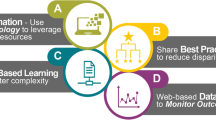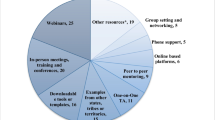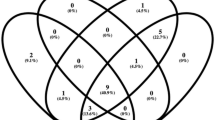Abstract
This paper explores how, through its extensive network of partners, the Comprehensive Cancer Control National Partnership (National Partnership) has provided a robust array of trainings, learning institutes, webinars, workshops, mentorship programs, and direct technical assistance to comprehensive cancer control programs and coalitions over the past 20 years. Mapping these activities to specific cancer control competencies revealed that the efforts of the National Partnership adequately address the core competencies necessary for an effective workforce and have the potential to increase practitioner capacity to adopt and implement evidence-based cancer control programs. Ensuring the continued availability and uptake of these tools, trainings and partnerships could potentially address gaps and barriers in the public health workforce related to evidence-based practice.

Similar content being viewed by others
References
Hohman K, Rochester P, Kean T, Belle-Isle L (2010) The CCC National Partnership: an example of organizations collaborating on comprehensive cancer control. Cancer Causes Control 21(12):1979–1985
All Hands on Deck: Making the Case for Comprehensive Cancer Control Retrieved from https://smhs.gwu.edu/cancercontroltap/sites/cancercontroltap/files/CCCNP%20Business%20Case%20Flyer%20-%20External.pdf. Accessed 10 May 2018
Ye J, Leep C, Robin N, Newman S (2015) Perception of workforce skills needed among public health professionals in local health departments: staff versus top executives. J Public Health Manag Pract 21(Suppl 6):S151–S158
Tilson H, Gebbie KM (2004) The public health workforce. Annu Rev Public Health 25:341–356
Institute of Medicine (2003) The future of the public’s health in the 21st century. The National Academies Press, Washington, DC
Fineberg HV, Green GM, Ware JH, Anderson BL (1994) Changing public health training needs: professional education and the paradigm of public health. Annu Rev Public Health 15:237–257
Rochester PW, Townsend JS, Given L, Krebill H, Balderrama S, Vinson C (2010) Comprehensive cancer control: progress and accomplishments. Cancer Causes Control 21(12):1967–1977
Vinson C, La Porta M, Todd W, Palafox NA, Wilson KM, Fairley T (2010) Research and comprehensive cancer control coalitions. Cancer Causes Control 21(12):2033–2040
Hohman K, Rochester P, Kean T, Belle-Isle L (2010) The CCC National Partnership: an example of organizations collaborating on comprehensive cancer control. Cancer Causes Control 21:1979. https://doi.org/10.1007/s10552-010-9644-0
https://www.grants.gov/web/grants/search-grants.html?keywords=dp17%201701
Hannon PA, Fernandez ME, Williams RS, Mullen PD, Escoffery C, Kreuter MW et al (2010) Cancer control planners’ perceptions and use of evidence-based programs. J Public Health Manag Pract 16(3):E1–E8
La Porta M, Hagood H, Kornfeld J, Treiman K (2007) Partnership as a means for reaching special populations: evaluating the NCI’s CIS Partnership Program. J Cancer Educ 22(1 Suppl):S35–S40
Andrew C, von Eschenbach (2005) Foreword. J Health Commun 10(Suppl 1):5. https://doi.org/10.1080/10810730500257614
Perocchia RS, Galassi A, Jacobs R, Krauss N, Kim LeMaitre M, Rutledge S (2007) The NCI’s Cancer Information Service Staff Training Program: A Foundation for Excellence. J Cancer Educ 22(S1):S8–S17. https://doi.org/10.1080/08858190701348091
Sanchez MA, Vinson CA, Porta ML, Viswanath K, Kerner JF, Glasgow RE (2012) Evolution of Cancer Control P.L.A.N.E.T.: moving research into practice. Cancer Causes Control 23(7):1205–1212
National Cancer Institute. Research Tested Intervention Programs (RTIPs) National Cancer Institute; Bethesda, MD (2018) https://rtips.cancer.gov. Accessed 20 July 2018
Farrell MM, La Porta M, Gallagher A, Vinson C, Bernal SB (2014) Research to reality: moving evidence into practice through an online community of practice. Prev Chronic Dis 11:130272
Purcell EP, Mitchell C, Celestin MD, Evans KR, Haynes V, McFall A, Troyer L, Sanchez MA (2013) Research to Reality (R2R) Mentorship Program: building partnership, capacity, and evidence. Health Promot Pract 14(3): 321–327
https://cancercontrol.cancer.gov/brp/tcrb/cessation-initiative.html
https://cancercontrol.cancer.gov/pdf/Rural-Abstract-Sep-2018-003.pdf
Brawley OW, Gansler T, Wender RC (2018) Toward the control of cancer. CA: A Cancer J Clin. https://doi.org/10.3322/caac.21461
Leeman J, Calancie L, Hartman MA et al (2015) What strategies are used to build practitioners’ capacity to implement community-based interventions and are they effective?: A systematic review. Implement Sci 10:80
https://cancercenter.gwu.edu/for-health-professionals/training-education. Accessed 28 Sept 2018
Sanchez M, Purcell EP, Michie JS, Tsakraklides SP, La Porta M, Vinson C (2014) Building cancer control capacity: A mixed-method evaluation of the research to reality (R2R) mentorship program. Prev Chronic Dis 11:E24
Purcell EP, Mitchell C, Celestin MD et al (2013) Research to reality (R2R) mentorship program. Health Promot Pract 14(3):321–327
Research To Reality. About R2R Mentorship Program. https://researchtoreality.cancer.gov/mentorship/about. Accessed 13 Mar 2018
National Association of County and City Health Officials (NACCHO). Building Local Comprehensive Cancer Control Coalitions: Lessons Learned from Local Health Departments. 2013.https://bit.ly/2KYaGMx. Accessed 20 July 2018
Weiss S, Ruhe M, Green T (2018) Local implementation and capacity of cancer prevention and control: a National Review of Local Health Department Activities. National Association of County and City Health Officials, Washington, DC
Susan G. Komen for the Cure. Local Community Health Programs. https://ww5.komen.org/WhatWeDo/IntheCommunity/LocalCommunityHealthPrograms/LocalCommunityHealthPrograms.html. Accessed 20 July 2018
Heston AH, Schwartz AL, Justice-Gardiner H, Hohman KH (2015) Addressing physical activity needs of survivors by developing a community-based exercise program: LIVESTRONG® at the YMCA. Clin J Oncol Nurs 19(2):213–217. https://doi.org/10.1188/15.CJON.213-217
Irwin ML, Cartmel B, Harrigan M, Sanft TB, Wong C, Hughes M, Hootsmans N, Winterhalter B, Shockro L, O’Connor K, Tolaney SM, Mayer EL, Yung RL, Freedman RA, Ligibel JA (2015) Impact of the LIVESTRONG at the YMCA Program on physical activity, fitness, and quality of life in cancer survivors. J Clin Oncol 33(15_suppl):9508–9508
Irwin ML, Cartmel B, Harrigan M, Li F, Sanft T, Shockro L, O’connor K, Campbell N, Tolaney SM, Mayer EL, Ligibel JA (2017) Effect of the LIVESTRONG® at the YMCA exercise program on physical activity, fitness, quality of life and fatigue in cancer survivors. Cancer 123(7):1249–1258. https://doi.org/10.1002/cncr.30456
Brownson RC, Fielding JE, Maylahn CM (2009) Evidence-based public health: a fundamental concept for public health practice. Annu Rev Public Health 30:175–201
https://www.hud.gov/program_offices/healthy_homes/smokefree. Accessed 28 Sept 2018
Fields RP, Stamatakis KA, Duggan K, Brownson RC (2015) Importance of scientific resources among local public health practitioners. Am J Public Health 105(suppl 2):S288–S294
Jacob R, Allen P, Ahrendt L, Brownson R (2017) Learning about and using research evidence among public health practitioners. Am J Prev Med 52(3S3):S304–S308
Acknowledgments
The authors thank Sarah Shafir, Lorrie Graaf, and Todd Tyler of the American Cancer Society and Dalena Nguyen, formerly of the National Cancer Institute, for their assistance in data collection and presentation. This research was supported in part by an appointment (K. Gibson) to the Research Participation Program at the Centers for Disease Control and Prevention administered by the Oak Ridge Institute for Science and Education through an interagency agreement between the U.S. Department of Energy and the Centers for Disease Control and Prevention.
Author information
Authors and Affiliations
Corresponding author
Ethics declarations
Conflict of interest
The authors declare that they have no conflict of interest.
Additional information
Disclaimer
The findings and conclusions in this report are those of the authors and do not necessarily represent the official position of the National Cancer Institute or the Centers for Disease Control and Prevention.
Rights and permissions
About this article
Cite this article
Farrell, M.M., Gibson, K.M., Marler, A. et al. How the Comprehensive Cancer Control National Partnership shapes the public health workforce. Cancer Causes Control 29, 1205–1220 (2018). https://doi.org/10.1007/s10552-018-1110-4
Received:
Accepted:
Published:
Issue Date:
DOI: https://doi.org/10.1007/s10552-018-1110-4




